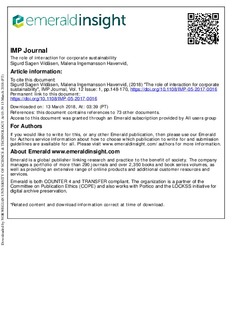| dc.description.abstract | Purpose
Most scholars acknowledge the role of firm-stakeholder relationship for enabling corporate sustainability (CS), but existing literature tends to apply a superficial understanding of interaction. Thus, the purpose of this paper is to advance knowledge by challenging classical stakeholder theory with fundamental insights from the IMP perspective, which in turn leads to a deeper conceptualization of interactive CS.
Design/methodology/approach
A typology framework is developed through an abductive research design grounded in the concepts of actors, resources, and activities. The authors illustrate the potential of the framework through a longitudinal case study. The empirical case revolves around an initiative for recycling of plastic material in a partly beforehand established supply chain, and the study reveals three main findings.
Findings
First, recycling solutions can result in major technological challenges. For example, using recycled material can jeopardize industrial quality standards. Second, third-party stakeholders represent critical knowledge and competence that can remedy technological challenges. Finally, R&D projects are important means for developing firm-stakeholder relationships.
Research limitations/implications
The paper introduces IMP concepts to the CS debate, which can illuminate the emerging literature on tensions and paradoxes related to CS phenomena. Further research is needed on the role of non-business actors as capacity generators for social and environmental change in traditional business networks.
Practical implications
The proposed framework can be used to analyze why some stakeholders (individuals and groups) turn into contributing actors in inter-organizational relationships, while others remain latent.
Originality/value
This paper illustrates the usefulness of actor bonds, resource ties and activity links as explanatory concepts. Moreover, developed relationships in terms of collaboration and networks represent a capacity to change, which is overlooked in current CS debates. | nb_NO |

